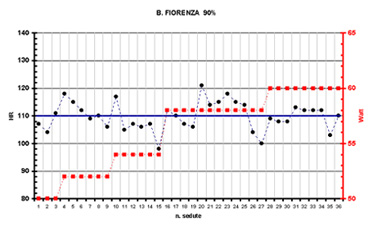

|
links
|
- Spectral and Cross-spectral analysis of heart period and blood pressure during and after exercise.
- Oxygen Uptake Kinetics During Exercise: influence of age, training and exercise intensity.
- Development of cardiovascular training programs
- Spectral and Cross-spectral analysis of heart period and blood pressure during and after exercise.
The modulation of the autonomic nervous system, and the relative roles of the sympathetic and parasympathetic activities may be addressed by spectral analysis of spontaneous beat-to-beat variability of non-invasively obtained heart rate and blood pressure records. In normal subjects spectral analysis of the heart period yields two principal peaks, corresponding to a high frequency (respiratory " 0.25 Hz) and a low frequency (0.04-0.15 Hz) component. The former reflects the respiratory sinus arrhythmia, and is almost entirely due to fluctuations in vagal efferent activity, while the latter, originally attributed to sympathetic mechanisms, is still rather controversial. The power spectrum of systolic blood pressure (SAP) holds equivalent oscillatory components: at high frequency, reflecting changes in intrathoracic pressure, and at low frequency, as a result of oscillations of the sympathetic vasomotor tone. Multivariate cross-spectral analysis of heart rate and arterial blood pressure time series can also be performed, to study interrelations between the two variables in the frequency domain. In particular, the gain of the transfer function linking RR and SAP in the low frequency range may achieve significance as an estimate of the strength of the baroreflex. more details


| Left Figure.
From top to bottom: Time series of R-R interval (RR), Systolic arterial
pressure (SAP), Dyastolic arterial pressure (DAP), Mean Arterial Pressure
(MAP) Right Figure.Spectral and cross-spectral analysis from a sample subject. From top to bottom: RR, SAP, Phase shift, coherence, and Transfer function gain (TFG) between RR and SAP. Before (CONTROL), and 15 (R15), 60 (R60) and 180 (R180) min after the end of exercise (50% AT). |
- Oxygen Uptake Kinetics During Exercise: influence of age, training and exercise intensity.
The nature of VO2 kinetics is a function of exercise intensity. During constant workload exercise at a work rate below LT, VO2 increases exponentially toward a steady-state level within 3 minutes. For exercise at intensities above Lactate Threshold the VO2 kinetics become more complex. After few minutes of work, an additional component is developed delaying or denying the attainment of a true steady-state condition.. The rate of VO2 adjustment at the onset of exercise depends on the capacity of O2 delivery and/or O2 utilisation. It is still object of debate if the limiting factor of VO2 kinetics is "central" (delivery) or "peripheral" (utilisation). more details

| VO2 kinetics during a six-minute square-wave exercise above AT. |
- Development of cardiovascular training programs
Regular participation in cardiovascular training programs leads to large improvements, which can reduce and/or prevent a large number of functional (such as decrease of muscle mass, bone density, arterial compliance and energy metabolism) and health problems (such as coronary heart disease, diabetes, hypertension, obesity). Although current research provides a great deal of data about exercise prescription the adjustment of exercise intensity during training has not been fully addressed. In fact, training prescriptions are often limited to exercise intensity, frequency and duration, while, in daily practice, trainers have little methods to adjust workloads according to individual improvements. Although ratings of perceived exertion (RPE) can be used as an indicator of physical strain during dynamic exercise, we believe that direct monitoring of heart rate should be preferred when possible. For this reason the implementation of automatic and direct effort-recording devices in cardiovascular training equipments, and development of algorithms and softwares to monitor and regulate the workload could represent a significant improvement for health and fitness industry.
